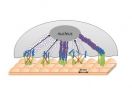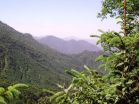(Press-News.org) An international team of researchers have developed a new method for measurement of aggregated beta-amyloid – a protein complex believed to cause major nerve cell damage and dysfunction in Alzheimer's disease. The new method might facilitate diagnosis and detection as well as development of drugs directed against aggregated beta-amyloid.
Alzheimer's disease (AD) is the most common cause of memory decline and dementia. According to the Alzheimer World Report 2011, today around 36 million people suffer from Dementia (around 20 - 25 million are Alzheimer's patients). These numbers will dramatically increase with the aging populations over the next few decades. For the year 2050 the expected number of dementia patients will be 115 - 200 million (70 – 150 million Alzheimer's cases). It is therefore important to develop new therapies and diagnostic methods to detect and treat this complex chronic neurodegenerative brain disease.
Alzheimer's disease is characterized by aggregates in the brain, containing a protein called beta-amyloid. The neuropathology of Alzheimer's disease has recently been linked to the neurotoxic amyloid-β (Aβ) oligomers. The crucial role of Aβ oligomers in the early events of AD is experimentally underlined. Several recent results suggest that those oligomers may cause the death of neurons and neurological dysfunctions relevant to memory. Furthermore Aβ oligomers levels are increased in brain and cerebrospinal fluid samples from people with Alzheimer's disease. This reflects the potential of Aβ oligomers as a marker for the early diagnosis of the disease.
An international team of scientists from Germany, Sweden and the U.S. have used a new method to quantify soluble variants of aggregated beta-amyloid (Aβ oligomers) in cerebrospinal fluid by flow cytometry. "We found that patients with a greater number of Aβ oligomers in the cerebrospinal fluid had a more pronounced disease," says Dr. Alexander Navarrete Santos (the developer of this method and now employee of the Research Laboratory of the University of Halle, Department of Cardiothoracic Surgery), and first author of the study.
He analyzed the cerebrospinal fluid of 30 neurological patients, including 14 Alzheimer's patients. "These samples provided from leading expert academic memory clinics in Germany and Sweden are of the best quality and are highly characterized in order to provide robust and reliable results on promising novel biomarker candidates", Professor Harald Hampel of Frankfurt University, a lead investigator comments.
"Because of the limited number of samples, however, further study is needed to confirm the results," said Dr. Oskar Hansson of Lund University. The study was an international cooperation with the University of California in the U.S., the Goteborg and Malmö Universities from Sweden and the University of Frankfurt in Germany.
The test might not only be used for the early detection of AD but can also be used when developing new and effective therapies for AD. A decline in the number of Aβ oligomers in cerebrospinal fluids could be a hint for the effectiveness of new drug therapies.
###The results of the study will appear in the internationally renowned scientific magazine Journal of Alzheimer's Disease in March 2012. Oskar Hansson (Lund University, Sweden) and Harald Hampel (University of Frankfurt, Germany) as senior authors of the study coordinated and supervised the work of the international research team including Drs. Alexander Navarrete Santos, Michael Ewers, Lennart Minthon, Andreas Simm, Rolf-Edgar Silver, Kaj Blennow, and David Prvulovic.
A new test might facilitate diagnosis and drug development for Alzheimer's disease
2012-03-26
ELSE PRESS RELEASES FROM THIS DATE:
New ORNL tool developed to assess global freshwater stress
2012-03-26
A new method to make better use of vast amounts of data related to global geography, population and climate may help determine the relative importance of population increases vs. climate change.
While several recent studies suggest that much of the world is likely to experience freshwater shortages as the population increases and temperatures rise, determining the relative impact of each has been difficult. An Oak Ridge National Laboratory paper published in Computers & Geosciences outlines a process that might help.
"Our work establishes a new method to couple geographic ...
'Bed-of-nails' breast implant deters cancer cells
2012-03-26
PROVIDENCE, R.I. [Brown University] -- One in eight women in the United States will develop breast cancer. Of those, many will undergo surgery to remove the tumor and will require some kind of breast reconstruction afterward, often involving implants. Cancer is an elusive target, though, and malignant cells return for as many as one-fifth of women originally diagnosed, according to the American Cancer Society.
Would it be possible to engineer implant materials that might drive down that rate of relapse? Brown University biomedical scientists report some promising advances. ...
Huge hamsters and pint-sized porcupines thrive on islands
2012-03-26
DURHAM, N.C. -- From miniature elephants to monster mice, and even Hobbit-sized humans, size changes in island animals are well-known to science. Biologists have long believed that large animals evolving on islands tend to get smaller, while small animals tend to get bigger, a generalization they call "the island rule."
A new study by researchers at Duke University and the National Evolutionary Synthesis Center in Durham, NC puts that old idea to the test in island and mainland rodents.
"Some of the size changes observed in island animals are pretty dramatic," said ...
Researchers unveil robot jellyfish built on nanotechnology
2012-03-26
Researchers at The University of Texas at Dallas and Virginia Tech have created an undersea vehicle inspired by the common jellyfish that runs on renewable energy and could be used in ocean rescue and surveillance missions.
In a study published this week in Smart Materials and Structures, scientists created a robotic jellyfish, dubbed Robojelly, that feeds off hydrogen and oxygen gases found in water.
"We've created an underwater robot that doesn't need batteries or electricity," said Dr. Yonas Tadesse, assistant professor of mechanical engineering at UT Dallas and ...
Possible causes of sudden onset OCD in kids broadened
2012-03-26
Criteria for a broadened syndrome of acute onset obsessive compulsive disorder (OCD) have been proposed by a National Institutes of Health scientist and her colleagues. The syndrome, Pediatric Acute-onset Neuropsychiatric Syndrome (PANS), includes children and teens that suddenly develop on-again/off-again OCD symptoms or abnormal eating behaviors, along with other psychiatric symptoms – without any known cause.
PANS expands on Pediatric Autoimmune Neuropsychiatric Disorder Associated with Streptococcus (PANDAS), which is limited to a subset of cases traceable to ...
UN hits water target, but 1.8 billion people still drinking unsafe water, study shows
2012-03-26
Recent widespread news coverage heralded the success of a United Nations' goal of greatly improving access to safe drinking water around the world.
But while major progress has been made, a new study from the University of North Carolina at Chapel Hill indicates that far greater challenges persist than headline statistics suggested.
Earlier this month (March 6), UNICEF and the World Health Organization issued a report stating that the world had met the U.N.'s Millennium Development Goal target of halving the proportion of people without access to safe drinking water, ...
Mountaintop blasting to mine the sky with the Giant Magellan Telescope
2012-03-26
Pasadena, CA--Astronomers have begun to blast 3 million cubic feet of rock from a mountaintop in the Chilean Andes to make room for what will be the world's largest telescope when completed near the end of the decade. The telescope will be located at the Carnegie Institution's Las Campanas Observatory—one of the world's premier astronomical sites, known for its pristine conditions and clear, dark skies. Over the next few months, more than 70 controlled blasts will break up the rock while leaving a solid bedrock foundation for the telescope and its precision scientific instruments.
The ...
Learning best when you rest: Sleeping after processing new info most effective, new study shows
2012-03-26
Nodding off in class may not be such a bad idea after all. New research from the University of Notre Dame shows that going to sleep shortly after learning new material is most beneficial for recall,
Titled "Memory for Semantically Related and Unrelated Declarative Information:
The Benefit of Sleep, the Cost of Wake," the study was published March 22 in PLOS One.
Notre Dame Psychologist Jessica Payne and colleagues studied 207 students who habitually slept for at least six hours per night. Participants were randomly assigned to study declarative, semantically ...
Researchers discover why humans began walking upright
2012-03-26
WASHINGTON—Most of us walk and carry items in our hands every day. These are seemingly simple activities that the majority of us don't question. But an international team of researchers, including Brian Richmond at the George Washington University, have discovered that human bipedalism, or walking upright, may have originated millions of years ago as an adaptation to carrying scarce, high-quality resources. This latest research was published in this month's "Current Biology."
The team of researchers from the U.S., England, Japan and Portugal investigated the behavior ...
Researchers develop new technique to assess diversity of plant species from afar
2012-03-26
EAST LANSING, Mich. --- By analyzing vegetation information collected by satellites over time instead of for just one day, scientists in the Michigan State University Center for Systems Integration and Sustainability (CSIS) have developed a novel procedure to assess the composition of plant species in an area.
Researchers long have used multi-spectral images (which include radiation outside human perception, such as infrared) and other remotely sensed data to create maps of vegetation around the globe. But seasonal changes in vegetation can limit the usefulness of these ...


